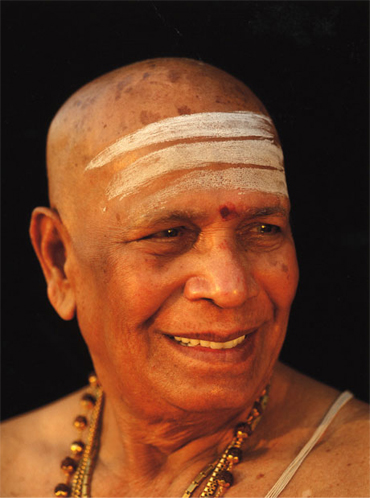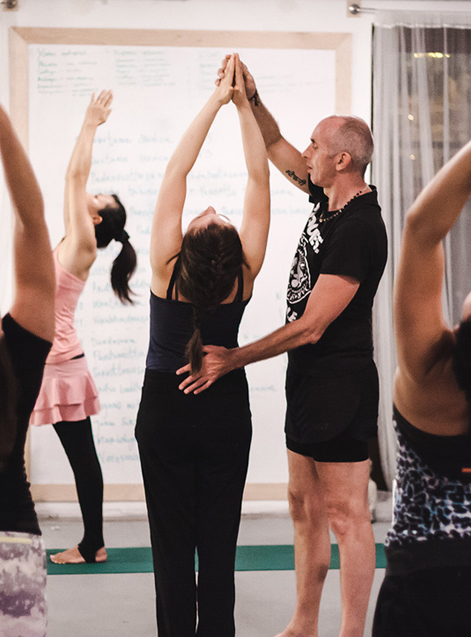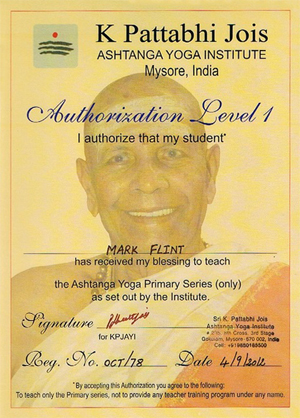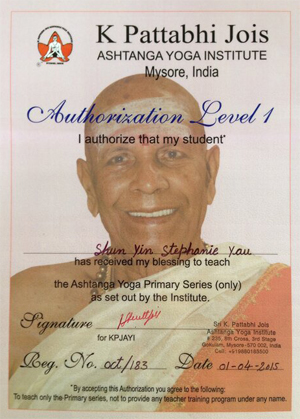
Pattabi Jois used to say “everyone can practice Ashtanga but a lazy person”
Practice within your own limitations, gradually go forward adding new asanas when you are ready, but most of all practice with awareness, ashtanga encourages you to learn about your own body and how it works.
In Ashtanga we have 3 main principles Bandha, (body locks) Ujayi Breath (breathing with sound) and Dhristi, (gazing point) when we bring these elements together we practice meditation in movement with Vinyasa.
Ashtanga yoga represents the 8 limbs of yoga, of which asana is number three.

5 external moral restraints.
Ahimsa – non violence.
Sathya – truthfulness.
Bramacharya – control of sexual desires.
Asthya – no stealing/ jealousy.
Aparigraha – non possessiveness, freedom from desire.
5 internal observances, self discipline.
Saucha – cleanliness, purity.
Santosha – contentment.
Tapas – austerity, self discipline.
Swadhya – self study and sacred texts.
Ishwara – worship of the supreme.
Moola bandha is situated around the perineum area, in the same place as mooladhaa chakra. Moola bandha is often referred to as the ‘master key’.
Uddiyana bandha is situated 3 fingers width below the naval, draw in at this point and hold on the inhale and the exhale, with practice when you draw in udiyana bandha, moola bandha will automatically engage, the energy joining together where they meet.
Pattabi Jois used to say, “hold Moola bandha and Uddiyana at all times, not just in your asana practice” this means when you are walking, driving, sitting etc. When practiced consistently it will make your internal core strong, it will prevent urinary and intestine problems and protect the lower back.
In ashtanga yoga it helps us separate the top half and the bottom half of the body so we can work them independently, making the body light. Try to keep bandha awareness throughout your yoga practice and link with your breathing even if you are only doing the hand exercises.
Jalandhara bandha is situated in the throat region, where Moola bandhaseals the bottom of the tube, Jalandhara bandha seals the top.
Jalandhar bandha is not engaged all the way through the practice like the other 2 but only in certain asanas.
Ujayi breath is simply breathing with sound it is not Ujayi pranayama
The ashtanga yoga primary series was created to burn the accumulated toxins from the body. With regular practice of asana, bandha and Ujayi breath we create an internal fire, burning up those toxins, if we tune in to the practice we can actually feel this purifying on the exhale.
All breathing should be done with the nose not the mouth.
Dristhi is the gazing point within the asana, which holds the attention, improves concentration and brings about a feeling of oneness, resulting in meditation in movement. We have different Dristhi for different asanas
Vinyasa can refer to the full sequence of the asanabut here refer to it as the transfer into and out of each asana, which keeps the body warm : Hatha Yoga Pradipika mentions ‘There is no yoga without Vinyasa’
Ashtanga yoga comes from the Yoga Korunta, an ancient manuscript discovered by T Krishnamacharya in the National Archives of India. The text is said to contain lists of different asana groupings as well as teachings on vinyasa, dristhi, bandha and mudra.
T Krishnamacharya is regarded as one of the most influential yoga teachers of the 20th century and can be credited with the revival of hatha yoga.
Ashtanga yoga series is a complete series for a healthy body and mind, the techniques involved have the capacity to rid the body of dis ease.
Ashtanga yoga began spreading in the 1960s and early 70s after the early foreigners from America and Europe came to practice with Pattabhi Jois in Mysore. In the 1980s when celebrities like Madonna, Sting, and Paul Simon started the practice, ashtangastarted spreading to most cities worldwide.


